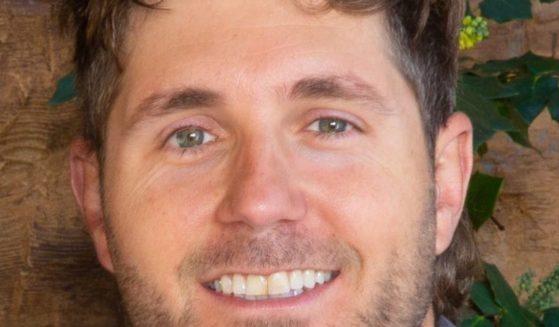Vandal Fells Ancient Tree Featured in 'Robin Hood,' Soon Realizes It Wasn't Just an Old Piece of Wood
The British people have good cause to mourn a terrible loss.
According to the U.K. Independent, a teenage vandal destroyed the iconic Sycamore Gap tree at Hadrian’s Wall in northeast England’s Northumberland County.
The 300-year-old Sycamore Gap tree appeared in Kevin Costner’s 1991 blockbuster film, “Robin Hood: Prince of Thieves.”
“A 16-year-old male was arrested in connection with the incident. He has since been released on police bail, pending further inquiries,” Northumbria Police and Crime Commissioner Kim McGuinness said.
McGuinness described herself as “incandescent” with rage over what “looks like a deliberate act of vandalism.”
The crime occurred overnight Wednesday and into Thursday morning.
We are shocked and desperately saddened to learn that the famous Sycamore Gap tree at Hadrian’s Wall has been felled overnight, in what appears to be an act of vandalism.
We know just how much this iconic tree is loved locally, nationally and by everyone who has visited.
We are… pic.twitter.com/QqLMhanzgC
— National Trust (@nationaltrust) September 28, 2023
Northumberland’s ancient Sycamore Gap tree stood at a slight dip in the landscape that made for a picturesque natural scene. Thus, in recent decades, it has become one of the most photographed trees in England.
Moreover, many regarded it as a symbol of the northeast region. Men proposed to their wives at the site. It had meaning beyond that of an ordinary tree.
Part of that meaning stemmed from its almost incomprehensible connection to the British past. A tree that dated to the early 18th century witnessed so much of British history that anything prior to the tree’s existence hardly qualifies as “British.”
The 1707 Act of Union between England and Scotland created “Great Britain.” The now-felled Sycamore Gap tree began to grow in that era. Isaac Newton still lived.
Furthermore, the tree grew near Hadrian’s Wall. Britannia’s Roman conquerors began building that wall in the second century AD.
Britons’ grief and outrage over the tree’s destruction stems in part from that history — but only in part.
Si King of the Hairy Bikers duo, a prominent pair of British “foodie” authors and television personalities, had powerful words to describe the loss.
The vandal, King said, had “murdered a sentinel of time and elemental spirit of Northumberland.”
Sean O’Grady of the the Independent struggled to understand his own grief over the tree’s loss.
“Seeing it lying there, stricken, helpless, slowing dying makes one irrationally depressed – it’s only a tree, you try to tell yourself,” he wrote. “I’d never met the tree, after all. But, like many of us, it was a sad – even sickening – sight.”
The BBC reported similar reactions.
“People have had their ashes scattered there. People have proposed there. I’ve picnicked there with my wife and kids. It’s part of our collective soul,” North of Tyne mayor Jamie Driscoll said.
Jack Taylor of the Woodland Trust conservation charity felt nothing charitable toward the culprit.
“If it has been deliberately felled, as reports suggest, this is totally unforgiveable,” Taylor told the BBC.
Photographer Ian Sproat described his reaction as “gobsmacked, anger set in and now sadness.”
“It’s a living thing. I keep asking myself, ‘why would anyone do this?'” Sproat said.
Human beings do not often use phrases such as “murdered,” “stricken, helpless, slowly dying,” “part of our collective soul,” “totally unforgiveable” and “why would anyone do this?” in reference to a lost tree. That fact requires some reflection that goes beyond even the tree’s historical links.
While we shudder at the tree’s senseless destruction, we can almost guess at the 16-year-old boy’s motives.
Perhaps he destroyed the tree in a too-common outburst of teenage nihilism — destruction for its own sake. Or, perhaps he did it on a dare.
Either way, I do not think the ensuing grief stems from the boy’s reasoning. Indeed, something else lay behind that grief.
In many photographs, the Sycamore Gap tree — framed by the hills and sky — looked truly majestic. We would be forgiven for feeling joy while imagining that it had come to us from somewhere else.
Legendary Christian author C.S. Lewis described this feeling as akin to a longing for something we cannot realize.
“The longings which arise in us when we first fall in love, or first think of some foreign country, or first take up some subject that excites us, are longings which no marriage, no travel, no learning, can really satisfy,” Lewis wrote in his 1952 book, “Mere Christianity.”
“There was something we grasped at, in that first moment of longing, which just fades away in the reality,” he added.
Lewis regarded this unfulfilled longing as evidence that our true home lay elsewhere.
“If I find in myself a desire which no experience in this world can satisfy, the most probable explanation is that I was made for another world,” he wrote.
Love, travel and knowledge excite that longing. So does a majestic natural beauty that connects us with our ancestors.
Christians believe that this longing comes from God and that earthly joys offer a fleeting glimpse of our heavenly home.
When I reflect on my feeling of awe at the fact that the Sycamore Gap tree dates to the age of the first Hanoverian kings, it does not mean that I long to live in that age or to meet those kings. It means that I long for the feeling of awe itself.
The Sycamore Gap tree inspired that feeling. Its beauty gave us a fleeting glimpse.
Thus, we do not mourn the tree as a tree. We mourn its loss as a source of the longing we crave.
Truth and Accuracy
We are committed to truth and accuracy in all of our journalism. Read our editorial standards.












